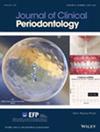牙周炎母亲及其危险后代的龈下宿主-微生物景观。
IF 6.8
1区 医学
Q1 DENTISTRY, ORAL SURGERY & MEDICINE
引用次数: 0
摘要
目的评估牙周炎母亲及其后代的龈下蛋白质组和微生物组,从而评估牙周病的特征。方法将患牙周炎的母亲及其后代和牙周健康的母亲及其后代分为四组,共40例。评估牙周临床参数。龈沟液(GCF)和龈下生物膜在同一部位采集。采用数据独立获取的液相色谱-串联质谱法(DIA-PASEF)对GCF的蛋白质组进行了研究。采用16S rRNA基因对龈下生物膜细菌DNA进行测序并进行分类。结果共定量6147个细菌和人蛋白(≥2多肽)。尽管没有依恋丧失,牙周炎母亲的后代表现出与其母亲相似的蛋白质型,其特征是炎症反应级联上调和上皮屏障蛋白下调。与对照组相比,他们也表现出更高的牙周病病原体定植模式,同时表现出细菌毒力蛋白的表达增加。结论母体牙周微生物组和蛋白质组与子代牙周微生物组和蛋白质组相关,与母体牙周状况有关。这些早期的生态事件可能潜在地促进后代对生态失调的易感性,并可能使他们易患牙周炎。本文章由计算机程序翻译,如有差异,请以英文原文为准。
The Subgingival Host-Microbial Landscape in Mothers With Periodontitis and Their At-Risk Offspring.
AIM
To evaluate the subgingival proteome and microbiome of mothers with periodontitis and their offspring, thereby assessing signatures of periodontal diseases.
METHODS
Forty participants in four groups were included: mothers with periodontitis and their offspring, as well as periodontally healthy mothers and their offspring. Periodontal clinical parameters were assessed. Gingival crevicular fluid (GCF) and subgingival biofilm were collected from the same sites. Proteome from GCF was investigated by liquid chromatography-tandem mass spectrometry with data-independent acquisition (DIA-PASEF). Bacterial DNA from subgingival biofilms was sequenced using the 16S rRNA gene for taxonomy assignment.
RESULTS
Overall, 6147 bacterial and human proteins (≥ 2 peptides) were quantified. Despite the absence of attachment loss, the offspring of mothers with periodontitis presented with similar proteotypes as their mothers, characterised by up-regulation of inflammatory response cascades and down-regulation of epithelial barrier proteins. They also displayed higher colonisation patterns by periodontopathogens while presenting with increased expression of bacterial virulence proteins compared with controls.
CONCLUSION
The study showed that the maternal periodontal microbiome and proteome associate with those of the offspring and relate to maternal periodontal status. These early ecological events may potentially promote offspring's susceptibility to dysbiosis and may predispose them to periodontitis.
求助全文
通过发布文献求助,成功后即可免费获取论文全文。
去求助
来源期刊

Journal of Clinical Periodontology
医学-牙科与口腔外科
CiteScore
13.30
自引率
10.40%
发文量
175
审稿时长
3-8 weeks
期刊介绍:
Journal of Clinical Periodontology was founded by the British, Dutch, French, German, Scandinavian, and Swiss Societies of Periodontology.
The aim of the Journal of Clinical Periodontology is to provide the platform for exchange of scientific and clinical progress in the field of Periodontology and allied disciplines, and to do so at the highest possible level. The Journal also aims to facilitate the application of new scientific knowledge to the daily practice of the concerned disciplines and addresses both practicing clinicians and academics. The Journal is the official publication of the European Federation of Periodontology but wishes to retain its international scope.
The Journal publishes original contributions of high scientific merit in the fields of periodontology and implant dentistry. Its scope encompasses the physiology and pathology of the periodontium, the tissue integration of dental implants, the biology and the modulation of periodontal and alveolar bone healing and regeneration, diagnosis, epidemiology, prevention and therapy of periodontal disease, the clinical aspects of tooth replacement with dental implants, and the comprehensive rehabilitation of the periodontal patient. Review articles by experts on new developments in basic and applied periodontal science and associated dental disciplines, advances in periodontal or implant techniques and procedures, and case reports which illustrate important new information are also welcome.
 求助内容:
求助内容: 应助结果提醒方式:
应助结果提醒方式:


